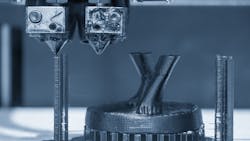3D Printer Emissions Standard (ANSI/CAN/UL 2904) Update Requires Reporting of THF and TDMCH or D7 for Non-industrial Use
A release issued by Chemical Insights Research Institute of UL Research Institutes reports that two new chemicals, tetrahydrofuran (THF) and tetradecamethylcycloheptasiloxane (TDMCHS or D7), have been added to the list of chemicals with required emissions criteria from operating 3D printers.
Both chemicals are frequently found to emit from operating printers, the release states. THF is a possible human carcinogen and was recently added to California’s Proposition 65 list. The cyclic siloxane (TDMCHS or D7) is a frequently found emission from 3D printers and adds to the total volatile organic compound (VOC) emission level.
The standard applies to freestanding 3D printers that are typically found in schools, offices, libraries, homes and other non-industrial indoor spaces. 3D printing produces ultrafine particles (UFPs), that when inhaled, have the tendency to penetrate deep into the lungs and even the bloodstream.
As part of the ongoing maintenance ANSI requirements, Chemical Insights Research Institute (CIRI) of UL Research Institutes, along with additional standard stakeholders, updated the consensus standard (ANSI/CAN/UL 2904) Standard Method for Testing and Assessing Particle and Chemical Emissions from 3D Printers (Standard).
READ MORE: ASME Publishes Updated Standard for 3D Printing | Machine Design
UFP, VOC Production Spurs Updates
These updates involve emissions from consumer-level material extrusion 3D printers that can produce UFPs and VOCs and are in response to feedback from stakeholders since the initial standard publication in 2019, according to the release.
Qian Zhang, Ph.D., a research scientist at CIRI, says, “We (CIRI) looked at material extrusion 3D printing, and started with non-industrial (or smaller scale) 3D printers, primarily because it is easier to build with what is already available for the methodology development. CIRI already had a chamber setup and analysis capability in this area. Secondarily, non-industrial environments are not typically monitored or regulated, so they’re usually less controlled and may have unknown issues.”
What does this mean for industrial 3D printing? According to Zhang, “Our testing method can be applied for industrial needs. This testing method will enable manufacturers to obtain reliable emission measurements, because it defines the measurement setups, analysis methods and evaluation protocols. In that way, emission characterizations can be compared in a fair manner—emission results can vary based on sampling method. These results can be generated from the manufacturers or testing parties as long as they follow the method.”
What the Standard Updates Include
Key standard updates include:
- Definitions of aldehydes and VOCs are clarified
- Instructions for print objects were updated
- Suggestions for additional particle characterizations are included
- Two new VOCs were added to the allowable emissions criteria list:
-- Tetradecamethylcycloheptasiloxane was added due to its high detect frequency from operating printers. Its maximum allowable emission rate is 25.0 mg hr-1 and maximum allowable concentration is 1200 µg m-3.
-- Tetrahydrofuran was added because of its potential health concern as a carcinogen. Its maximum allowable emission rate is 31.2 mg hr-1 and maximum allowable concentration is 1500 µg m-3. - Two VOCs were removed from the allowable emissions criteria list:
-- 1,2,4-trimethylbenzene was removed since trimethylbenzene is listed
-- Diethylhexyl phthalate was removed because it is a semi-volatile organic compound that may require other detection methods.
“Additionally, the criteria listed in the standard also apply for industrial printers,” Zhang says. “The emission factors (emission rate and yield) depend on specific printer/feedstock combination and the criteria are based on performance or regulations. Even though the standard defines concentration criteria for office environment setup, it also includes details of the modeling method that can be used to estimate concentration in industrial environment settings.”
ANSI/CAN/UL 2904 2nd Ed. is now available for digital download or hard copy purchase through UL Standards’ sales website.
About the Author
Sharon Spielman
Technical Editor, Machine Design
As Machine Design’s technical editor, Sharon Spielman produces content for the brand’s focus audience—design and multidisciplinary engineers. Her beat includes 3D printing/CAD; mechanical and motion systems, with an emphasis on pneumatics and linear motion; automation; robotics; and CNC machining.
Spielman has more than three decades of experience as a writer and editor for a range of B2B brands, including those that cover machine design; electrical design and manufacturing; interconnection technology; food and beverage manufacturing; process heating and cooling; finishing; and package converting.
Email: [email protected]
LinkedIn: @sharonspielman
Facebook: Machine Design
YouTube: @MachineDesign-EBM

